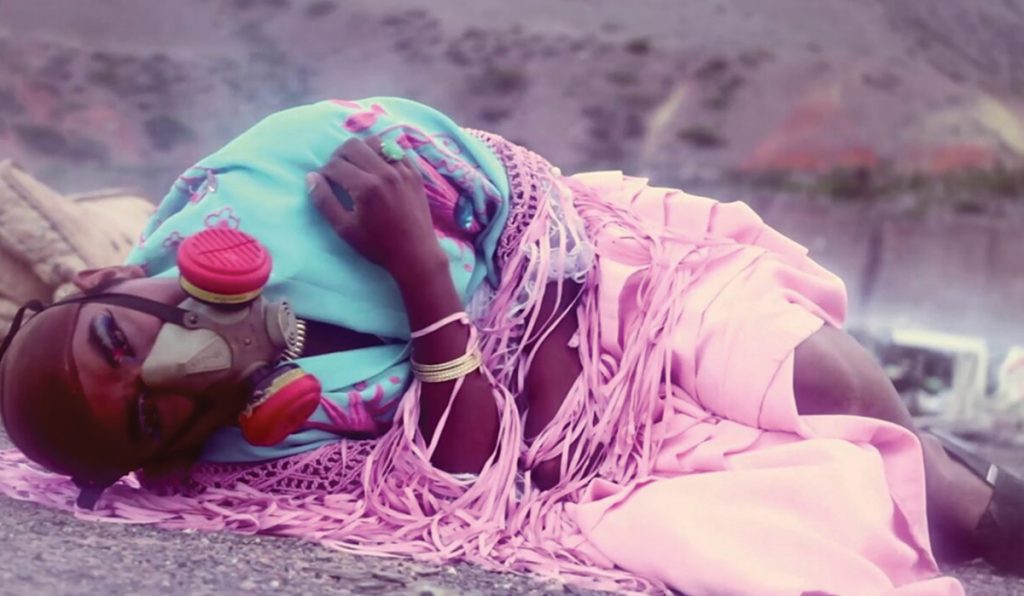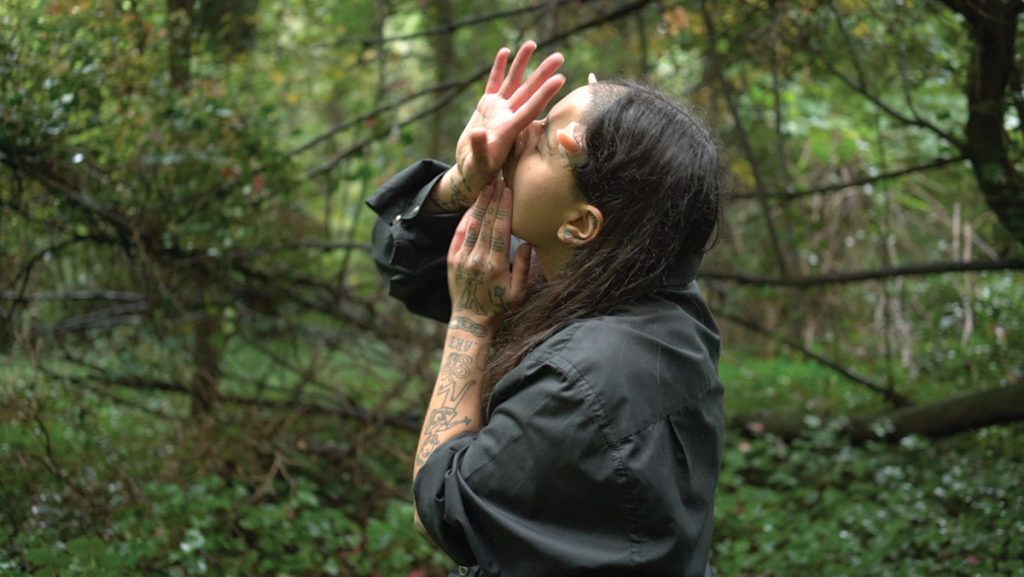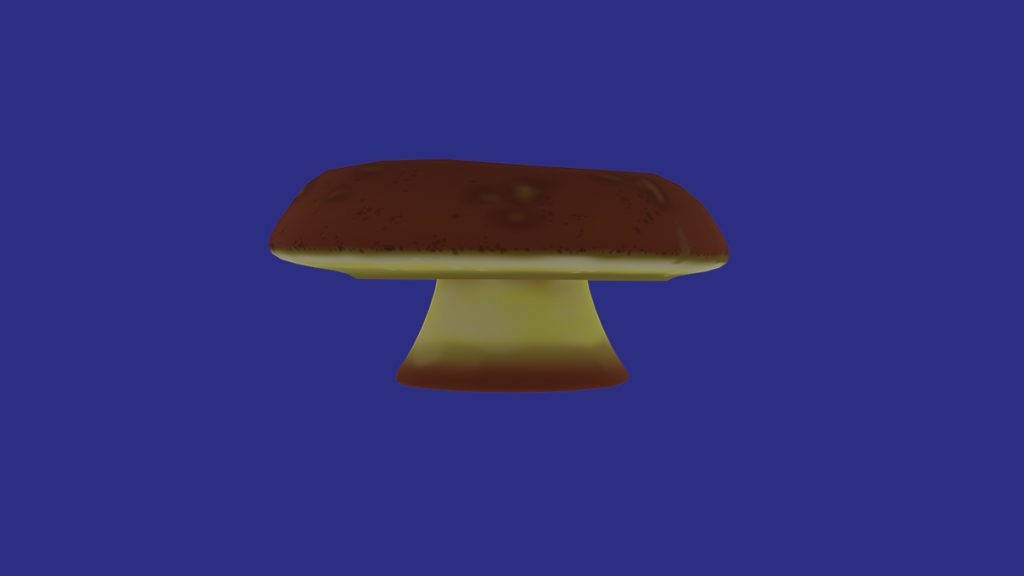When the Moon Waxes Red
“This is the story of what happens after your property and after your progress. It’s over. And baby, you didn’t survive.”

There is a widespread consensus that we are living at the end of a healthy planet and of civilization as we know it. And undoubtedly the collapse of nature is at the centre of this end-of-world narrative. To develop this plot further, we might no longer exist on planet Earth, as the narrator – quoted at the beginning of the text – proclaims in Everything but the World, an ironic TV show by DIS, that turns the camera on nature’s least natural invention: the humans (And baby, you didn’t survive).

Set within the prism of a trans apocalypse, the film presents a ‘natural history’ about the homo sapiens’ rise and fall closely linked to the fossil narrative of human history and the notions of ‘progress’.
Only a few years ago the Mediterranean region was declared one of the most vulnerable regions on earth. New advanced technologies of data modelling expect a rising temperature of 2.5 degrees celsius until 2040. The Mediterranean Sea is under threat due to low oxygen and few currents, intensification of maritime traffic, overfishing, deep sea mining, depletion of coastal ecosystems, sea-floor trawling, oil exploration and extraction, to name some of the ecocidal transformations.
So, see you hopefully in 2040, baby.
End of the story!
Unless….
The exhibition When the Moon Waxes Red at Spazju Kreattiv focuses most probably on the ‘unless’ of future scenarios and the options we still might have for saving the planet, by posing a central question: What if we replace the ‘end’ with ‘renew’? Renew our plot, our perspectives, our relationship with the planet or the scales of impacts, and read the earth inthe age of advanced climate crises freed from colonial or progress-driven thinking, that allows shifts in perspectives and norms and pluralises our ideas about the world and acknowledge that the current Western understanding of the future that has dominated the world for centuries will simply lead to a dead(ly) end.
Under the specific lens of ecocritical feminism, the show assembles artistic positions of female solidarity and care from around the world, aware that there is no ecological justice without social justice. French feminist Françoise d’Eaubonne coined the term Ecofeminism in 1974. Ecofeminism re-evaluates equality by offering a view of the world that respects organic processes, non-human perspectives, holistic connections, and the merits of intuition and collaboration. It conceptualises climate change, gender equality, and social injustice as intrinsically related issues, strongly tied to patriarchal dominance in society.

The dis/connection to oceans and rivers and their endangered ecosystems are ongoing concerns of ecocritical art, and according to the UN, climate change is primarily a water crisis. Cultural theorist Astrida Neimanis created the concept of ‘Hydrofeminism’ to develop a new mode of posthuman thinking that understands our bodies as being fundamentally part of the natural world and not separate from or privileged to it – connected through water. Water is the element that, more than any other, ties human beings into the world around them – from the oceans that surround us to the water that makes up most of our bodies. Those bodies of water interrelate and interact, no matter what and who they are. This different kind of hydrological cycle insists that we relinquish any lingering illusion of nature as separate from culture, or of humans as separate from the world around us.
New radical ways of more-than-human thinking, as Hydrofeminism or Tentacular Thinking proposes, introduced by scholar Donna Haraway, which similarly rethinks the position of humans in our ecosystems, brings forth practices to expand on the vital questions of socio-environmental, inter-species methodologies, as tackled in the works of Ursula Biemann and Robertina Šebjanič.
In her poetic sound piece, Atlantic Tales, Slovenian artist Robertina Šebjanič speculates on how the oceans feel the human actions, how these actions affect the inhabitants of the oceans and seas, and what they would tell us if we understood what they say. In a mix of a fictional story and scientific facts combined with mythological elements, the sound installation refers to the extinction of species amid the sixth mass extinction. While Robertina Šebjanič advocates the animals’ view, Ursula Biemann mediates the alarming situation through an indigenous futuristic scene. The science fictional story ‘Acoustic Ocean’ about a female Sami (indigenous Norwegian) scientist listening to the deep sea, allows us to dive into a living world that is constituted by an interdependent assemblage of human, marine, machinic, organic, climatic and digital elements – a world that in reality does not exist any longer due to heavy sound pollution in the oceans nowadays.
When the Moon Waxes Red is originally the book title by Vietnamese feminist filmmaker and theorist Trinh Minh-ha from 1991 on representation dominated by Western regimes of knowledge, and the call for changes. Changing the colours of the nocturnal light of the moon in Asian mythology often means an upcoming change of destiny. Changing colours as symbols for heralding fundamental chances, which intend the collapse of the familiar, refer undoubtedly to the time we live in.
That of a ‘great transition’, in which the conception of the era as well as the paradigm of the ‘known’ is heavily disrupted. In the first essay of her book, Trinh connects the human paradoxical idea of ‘colonising the moon, with the aim of coming closer to uniting the earth’ with re-reading the famous Asian mythological figure of the Chinese moon goddess Chang E in a feminist way. Trinh poetically argues for a multicultural revision of knowledge, so that new politics can transform reality rather than merely ideologize it.
Transforming the realities and liberating the power of representation has always been at the heart of feminist thinking and again more recently under the specific lens of climate justice and colonialism. It was only last year, in 2022, that for the first time in more than three decades since its inception, the most influential Intergovernmental Panel on Climate Change (IPCC) mentioned the term “colonialism” in a report. Leading climate scientists finally acknowledge that colonialism is a historic and ongoing driver of the climate crisis.
The take on colonialism and (climate) justice of Peruvian artist Daniela Ortiz is unique. Her series of paintings The Rebellion of Roots depicts sequences of situations in which tropical plants, held hostage in the botanical gardens and greenhouses of Europe, are protected and nurtured by the spirits of racialized people who died as a result of European racism. The Rebellion of Roots draws connections between current geopolitical events and colonial histories, underpinned by various forms of poetic justice. At once colourful, naive, and humorous, the paintings are also sobering and cruel. For example, Frontex officials (the agency that regulates European borders) die choking on ‘anti-colonial’ potatoes from the Andes or fall into the Seine, in the same spot where police repressed Algerian anti-colonial protests in 1961.

Another way of interpreting the ‘changing colour of the moon’ as a transactional space for critical storytelling is offered by Swiss-Haitian artist, Sasha Huber. Her work Karakia-The Resetting Ceremony draws on the historic dominance of Western natural science. In 2015, Huber travelled to the Agassiz Glacier in New Zealand, named after a Swiss geologist who promoted racial segregation in the 19th century. Huber organised a resetting ceremony, with a karakia (incantation) done by Māori Jeff Mahuika. This incantation served to symbolically un-name the glacier and free it from its association with Agassiz’s racist views.
Natural science in colonial history was hardly harmless, as the artist points out with her symbolic liberation. Geologists from the continent of Europe were sent to the ‘new’ continents to explore geological structures with clear colonial and imperialist interests.
In his not yet published book ‘Radical Futurism’ theorist TJ Demos draws on visions of climate justice to come emerging from the traditions of the oppressed. The consumption of the earth is an elemental part of capitalism and its extractive corporations. Those disproportionately affected by the depletion of the planet are the same people who, for centuries, have cared for and protected the land: indigenous communities, women, and people of colour. Even those that have already been displaced for generations, those living in ecological disconnect, who no longer have the possibility of being with the land. A being who has protected the earth for centuries.
Chilean artist Sebastián Calfuqueo, from Mapuche origin, depicts in their animation Mapu Kufüll (Land Seafood) the story of lost land and knowledge of survivalism from the indigenous perspective of the Mapuche people in Chile. Calfuqueo learned about Mapuche cosmovision through their grandmother, who had migrated to Santiago de Chile in the mid-twentieth century amid massive Mapuche mobilisation, escaping systematic discrimination and abuse in Wallmapu, the ancestral territory of the Mapuche people. In the video animation, we see a journey of a genderless child who is remembering their grandmother’s instructions to collect mushrooms, i.e., for instance, to cover the roots after extracting them to not damage the mycelium.

Gender stereotypes, colonialism, racism, environmental destruction and illegal land grabbing in Latin America are likewise contained in the work of Argentinian artist Maximiliano Mamani. In the video Ramita Seca, La Colonialidad Permanente (Dry Branch. The Permanent Colonialism), Andean drag queen Bartolina Xixa, an alter ego of the artist, dances in the middle of a rubbish dump. The song ends with the haunting verse: “We are the waste that this hygienic and aseptic world does not want to see. We are the ones who pay the ecological debts of those who squander us and transact in power”. The persona Xixa is a homage to the Bolivian revolutionary leader Bartolina Sisa Vargas (c. 1750–1782), a woman from the Indigenous Aymara ethnic group who fought the colonial occupation of their land in Peru and Bolivia.
Garbage as a result of overproduction is also at the centre of the Lebanese collective Folly Feast Lab’s Mediterranean Sea Diaries, a research and design project that imagines the future of spaces like landfills and (e-)wastelands. This work is part of the so-called Med Lab in the exhibition – a spatial collage – which gathers materials, reports, quotes, objects and artworks related to the Mediterranean region’s current ecological situation.
The thirteen exhibited projects and works of When the Moon Waxes Red – unfortunately not all artists are mentioned in this text – look into concepts that propose a different understanding of co-inhabiting the planet, such as indigenous ways of relating to nature by reviving the aesthetic and spiritual bonds between human and non-human interspecies entities and worlds. The struggles are understood as central in order to explore the possibilities of interweaving sometimes poetic, sometimes humorous gestures with radical political ideas of action. The majority of the presented works advocate forms of caring and curing, other than those which live or are taught to live, that bring new female or queer perspectives to bear on ideas of ecological ethics in this critical moment.
The exhibition heeds the call for a polyphonic view of life on this planet, where humans and non-humans, binary and non-binary subjects and matters have an equal say, and pays attention to the often unheard, unseen agencies, knowledge and futurisms.
WHEN THE MOON WAXES RED runs from Friday 10th March to Sunday 16th April 2023 at Space A, Spazju Kreattiv. It is a commission by Spazju Kreattiv, curated by Maren Richter, exhibition design by Keit Bonnici, and project managed by Ambra Anselmo; with artists Ursula Biemann, Seba Calfuqueo, DIS Collective, Charlene Galea, Romeo Roxman Gatt, Folly Feast Lab (Yara Feghali and Viviane El Kmati), Crystn Hunt Akron, Sasha Huber, Nation25 (Elena Abbiatici, Sara Alberani and Caterina Pecchioli), Daniela Ortiz, Kanthy Peng, Robertina Šebjanič and Bartolina Xixa.








